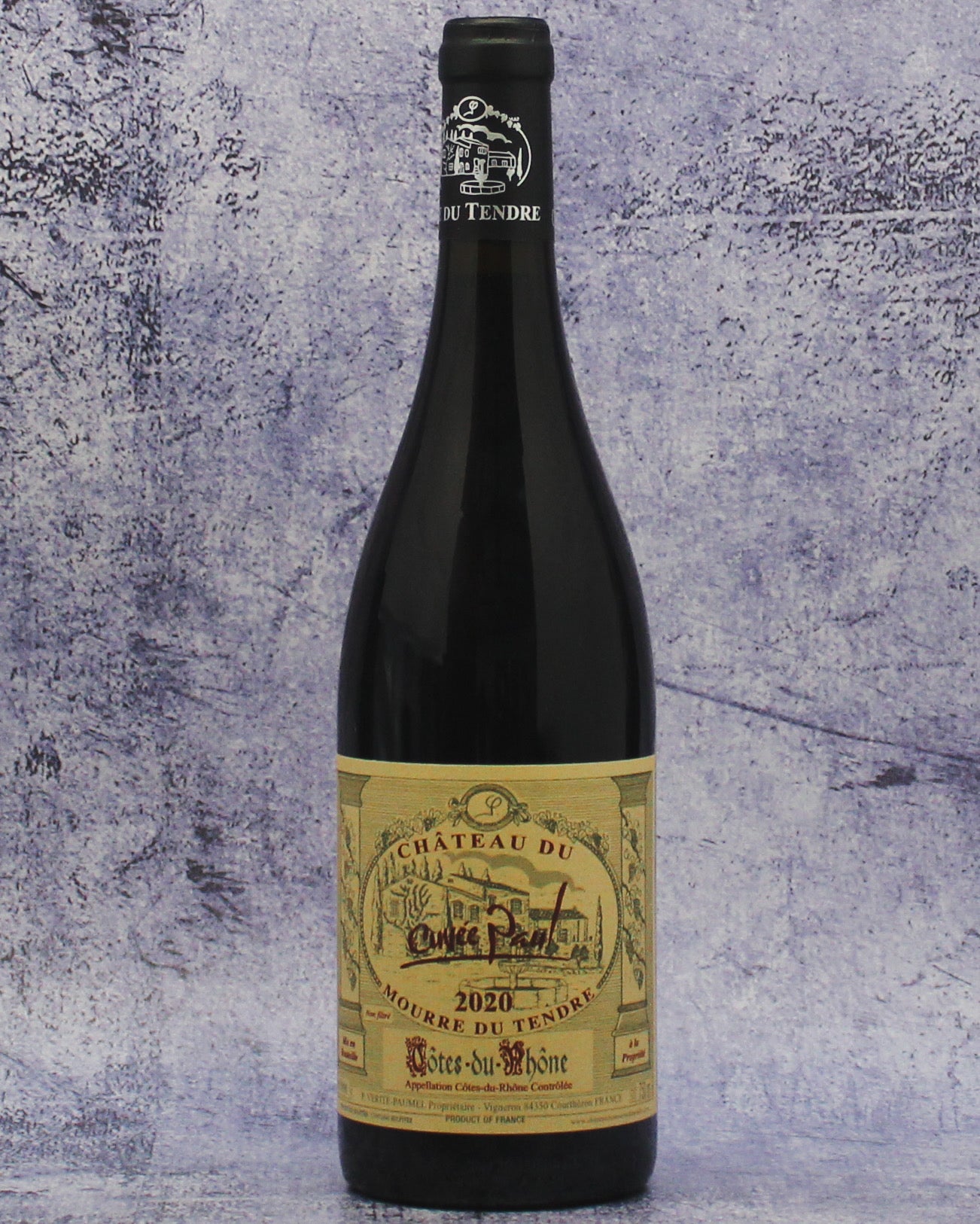From: Côtes-du-Rhône, France
Blend: Grenache, Carignan, Cinsault
Taste: An inviting blend of Grenache, Carignan, and Cinsault that's instantly approachable yet still remarkably complex. The 2018 vintage has a flattering nose brimming with many ripe (yet elegant) red berry fruits and a tickle of pepper. The palate is soft but with a beautiful structure that shows off subtle earth and baking spice components. We cannot overstate these wines' elegance and have been so impressed by this Côtes-du-Rhône rouge in its complexity, depth, "true-to-varietal(s)" and regional character. We came across the quote below and had to include it in our write-up, as it completely sums up our feelings about this estate.
“Why doesn’t Mourre de Tendre get the notoriety of something like Clos des Papes? Is it because the wine received an 89-91 barrel rating? If that’s true, that’s a joke. This wine is one of the most individual, rugged and potentially complex wines in all of Chateauneuf and it would be held on a mantle by most of you. Their old-school method of holding the wine until ready to drink (in this case, the 2001 is the current release) causes confusion in the marketplace but this practice is the same one employed by Henri Bonneau and it doesn’t seem to hurt his place in history. While this ritual is one that very few producers in Chateauneuf du Pape can afford to continue, it is more to do with pure economics than anything else – it is very costly to hold wine back for 5-6 years after the production vintage (when you could release it after only 12 months and let the consumer carry the burden of ageing) but Mourre de Tendre continues to do it and they will not deviate from their course. In the end, it’s about the wine and the blood, iron and pulp of old-vine Grenache that race around the structured and tannic frame of this beverage may be too much for some but I would argue it is the real soul of Chateauneuf du Pape. No luxury cuvee, no new oak, no tricks or games – a soapbox for my traditional rants? Maybe, but the wine is in the bottle – just give it a few more years (I actually think they could have held this back for 1-3 more years). This is a wine I purchase for my personal cellar as it harkens to an era circa 1970 or 1978 – one where the wall of galets pounding your palate was more of an indicator of worth than the toast level of the cooperage. “ Highly Recommended Jon Rimmerman, Garagiste
Pairing: This elegant and classic Côtes-du-Rhône rouge pairs best with all types of classic meat dishes, veal, pork, beef, lamb, duck, game, roast chicken, roasted, braised, stewed dishes, sausage and cassoulet. Mourre du Tendre is also good with Asian dishes (most things meat and rice, but please stay away from raw seafood pairings), mushrooms either sautéed as a ragù or in pasta or risotto (check out the recipe with polenta, below), and Mediterranean dishes that include eggplant and/or tomatoes.
Polenta With Wild Mushrooms and Marinara Sauce
By Martha Rose Shulman
About. For several generations the Paumel family has farmed grapes in the Rhône Valley. The current patriarch, Jacques Paumel took control of the estate in 1962 from his father, and in 1988 he and his wife Josephine decided to start estate bottling their own wines using the name of the hill on which their ancient provençale farmhouse and many of their vines are situated. Technically semi-retired, Jacques and Josephine have turned over the running of the estate to their daughter Florence and her son Paul Verité.
The Estate is now 25 hectares in size with 3 ha in Châteauneuf-du-Pape in the lieu-dits of La Crau, La Guigasse and Saintes Vierges. All are sandy terroirs. The Grenache found in these sites was planted in 1929 or in 1942 while the Mourvedre is a relatively recent addition, having been planted by Jacques in 1967. They have a 1.5 hectare plot of Grenache and Mourvedre, planted on clay limestone soil and located just outside the appellation of Châteauneuf du Pape in the lieu-dit of Clos de Grenadiers. The Grenache dates to 1925 and they are the oldest vines that the family owns. In 1969 Jacques planted Mourvedre and Grenache to supplement these old vines so it now totals 7 hectares. From this site the family makes their Côtes-du-Rhône Villages. In Plan de Dieu they have a newly acquired plot of 70-90 year old Grenache, Mourvedre, Cinsault and Syrah grown on gravelly red clay soils. Finally there are 10 hectares of Grenache, Cinsault and Carignan, also on clay limestone soils and quite near the cellars of Mourre du Tendre. These vines are the source of their Côtes-du-Rhône.
Farming at Mourre du Tendre is minimalist and traditional. Everything is done by hand and the family has never used pesticides in their vineyards. The harvest is conducted in several passes and the grapes are carefully sorted when they reach the cellar. The Paumel family makes powerful and traditional wines and the fruit is not destemmed, fermentations occur spontaneously after a short semi-carbonic maceration, and the elevage is quite long – averaging about three years in a combination of concrete tanks and foudre. The resulting wines are charming, bold and structured with much more in common with Barolo and Barbaresco than most anything else you will find in the region. Needless to say they age beautifully and gracefully, even the Côtes-du-Rhône.
This wine. Château du Mourre du Tendre farms 10 hectares of old-vine Grenache, Carignan and Cinsault in Côtes-du-Rhône on gravelly clay soils. While most estates opt for an easy-going style at the entry level, Paul Verité, the young vigneron at Mourre du Tendre treats this wine the same way that he does his Châteauneuf-du-Pape: whole cluster and native yeast fermentations that begin semi-carbonically and extensive aging (30 months) in tank before release.
The 2018 vintage report for the Rhône, by David Roberts MW.
“2018 continues the Rhône’s extraordinary run of fortune with this fourth consecutive high-class vintage.”
“This high quality spans all appellations, somewhat surprising for a region that covers almost 150 miles. No one appellation outperforms the other and, despite a challenging growing season, there are some excellent wines from both the North and South. However, vignerons might lament the 2018 vintage due to the tiny crop it yielded. This small quantity of wine is nevertheless of exceptional quality.
Vintages such as 2018 separate the wheat from the chaff. Location, terroir and careful vineyard management come to the fore. Once again, the most dedicated and talented producers have proven their worth, crafting truly excellent wines.
The essence of all great northern Rhône wines is Syrah, a varietal that thrives in heat and sunshine. 2018 delivered both in abundance and devotees will get great pleasure from this vintage. White wine lovers will find that alcohol levels are trimmed down compared to 2017 so the wines are arguably truer expression of their origins and grape varieties.
In the South, growers made the most of other varieties permitted in their appellations to tone down the natural exuberance and ripeness of Grenache in the final blend. The wines are stylish and approachable but maintain a core that will allow them to age as well as the finest vintages.”

